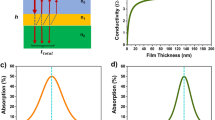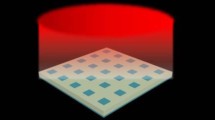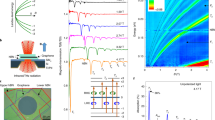Abstract
The study of magneto-optical absorption has stimulated diverse energy-technology-related explorations, showing potential in breaking the current theoretical efficiency limits of energy devices compared with reciprocal counterparts. However, experimentally realizing strong infrared non-reciprocal absorption remains an open challenge, and existing proposals of non-reciprocal absorbers are restricted to a narrow working waveband. Here we observe highly asymmetric absorption spectra over a broad mid-infrared band (nearly 10 μm) using doped InAs multilayers with gradient epsilon-near-zero frequencies. We reveal that the magnetized epsilon-near-zero behaviours and material loss play important roles in achieving strongly non-reciprocal absorption under a moderate external magnetic field using a thin epsilon-near-zero film (<λ/40, λ is the wavelength). Our approach enables flexible control over the working frequencies and non-reciprocal bandwidths by designing magnetized InAs films with different doping concentrations. The proposed principles can also be generalized to other III–V semiconductors, magnetized metals, topological Weyl semimetals, magnetized zero-index metamaterials and metasurfaces.
This is a preview of subscription content, access via your institution
Access options
Access Nature and 54 other Nature Portfolio journals
Get Nature+, our best-value online-access subscription
$29.99 / 30 days
cancel any time
Subscribe to this journal
Receive 12 print issues and online access
$259.00 per year
only $21.58 per issue
Buy this article
- Purchase on Springer Link
- Instant access to full article PDF
Prices may be subject to local taxes which are calculated during checkout




Similar content being viewed by others
Data availability
The data that support the plots within this paper and other findings of this study are available from the corresponding authors upon reasonable request.
References
Qin, J. et al. Nanophotonic devices based on magneto-optical materials: recent developments and applications. Nanophotonics 11, 2639–2659 (2022).
Kimel, A. et al. The 2022 magneto-optics roadmap. J. Phys. D Appl. Phys. 55, 463003 (2022).
Qin, J. et al. Ultrahigh figure-of-merit in metal–insulator–metal magnetoplasmonic sensors using low loss magneto-optical oxide thin films. ACS Photon. 4, 1403–1412 (2017).
Wang, Z., Chong, Y. D., Joannopoulos, J. D. & Soljačić, M. Reflection-free one-way edge modes in a gyromagnetic photonic crystal. Phys. Rev. Lett. 100, 013905 (2008).
Stadler, B. J. H. & Mizumoto, T. Integrated magneto-optical materials and isolators: a review. IEEE Photonics J. 6, 0600215 (2014).
Berent, M., Rangelov, A. A. & Vitanov, N. V. Broadband Faraday isolator. J. Opt. Soc. Am. A 30, 149–153 (2013).
Armelles, G., Cebollada, A., García-Martín, A. & González, M. U. Magnetoplasmonics: combining magnetic and plasmonic functionalities. Adv. Opt. Mater. 1, 10–35 (2013).
Belotelov, V. I. et al. Enhanced magneto-optical effects in magnetoplasmonic crystals. Nat. Nanotechnol. 6, 370–376 (2011).
Xia, S. et al. Enhancement of the Faraday effect and magneto-optical figure of merit in all-dielectric metasurfaces. ACS Photon. 9, 1240–1247 (2022).
Li, W., Buddhiraju, S. & Fan, S. Thermodynamic limits for simultaneous energy harvesting from the hot sun and cold outer space. Light Sci. Appl. 9, 68 (2020).
Park, Y., Zhao, B. & Fan, S. Reaching the ultimate efficiency of solar energy harvesting with a nonreciprocal multijunction solar cell. Nano Lett. 22, 448–452 (2022).
Jafari Ghalekohneh, S. & Zhao, B. Nonreciprocal solar thermophotovoltaics. Phys. Rev. Appl. 18, 034083 (2022).
Park, Y., Omair, Z. & Fan, S. Nonreciprocal thermophotovoltaic systems. ACS Photon. 9, 3943–3949 (2022).
Bornatici, M. Theory of electron cyclotron absorption of magnetized plasmas. Plasma Phys. 24, 629–638 (1982).
Bornatici, M. & Engelmann, F. Electron‐cyclotron absorption and emission: ‘vexatae quaestiones’. Phys. Plasmas 1, 189–198 (1994).
Palik, E. D. & Furdyna, J. K. Infrared and microwave magnetoplasma effects in semiconductors. Rep. Prog. Phys. 33, 1193–1322 (1970).
Zhang, Z. & Zhu, L. Nonreciprocal thermal photonics for energy conversion and radiative heat transfer. Phys. Rev. Appl. 18, 027001 (2022).
Zhu, L. & Fan, S. Near-complete violation of detailed balance in thermal radiation. Phys. Rev. B 90, 220301 (2014).
Zhao, B. et al. Near-complete violation of Kirchhoff’s law of thermal radiation with a 0.3 T magnetic field. Opt. Lett. 44, 4203–4206 (2019).
Zhao, B., Guo, C., Garcia, C. A. C., Narang, P. & Fan, S. Axion-field-enabled nonreciprocal thermal radiation in Weyl semimetals. Nano Lett. 20, 1923–1927 (2020).
Pajovic, S., Tsurimaki, Y., Qian, X. & Chen, G. Intrinsic nonreciprocal reflection and violation of Kirchhoff’s law of radiation in planar type-I magnetic Weyl semimetal surfaces. Phys. Rev. B 102, 165417 (2020).
Park, Y. et al. Violating Kirchhoff’s law of thermal radiation in semitransparent structures. ACS Photon. 8, 2417–2424 (2021).
Hadad, Y., Soric, J. C. & Alu, A. Breaking temporal symmetries for emission and absorption. Proc. Natl Acad. Sci. USA 113, 3471–3475 (2016).
Liu, M. Q. & Zhao, C. Y. Near-infrared nonreciprocal thermal emitters induced by asymmetric embedded eigenstates. Int. J. Heat. Mass Transf. 186, 122435 (2022).
Shayegan, K. J., Zhao, B., Kim, Y., Fan, S. & Atwater, H. A. Nonreciprocal infrared absorption via resonant magneto-optical coupling to InAs. Sci. Adv. 8, eabm4308 (2022).
Liu, T., Guo, C., Li, W. & Fan, S. Thermal photonics with broken symmetries. eLight 2, 25 (2022).
Kirchhoff, G. I. On the relation between the radiating and absorbing powers of different bodies for light and heat. Lond. Edinb. Dublin Philos. Mag. J. Sci. 20, 1–21 (1860).
Snyder, W. C., Wan, Z. & Li, X. Thermodynamic constraints on reflectance reciprocity and Kirchhoff’s law. Appl. Opt. 37, 3464 (1998).
Tsurimaki, Y. et al. Large nonreciprocal absorption and emission of radiation in type-I Weyl semimetals with time reversal symmetry breaking. Phys. Rev. B 101, 165426 (2020).
Ghanekar, A., Wang, J., Fan, S. & Povinelli, M. L. Violation of Kirchhoff’s law of thermal radiation with space–time modulated grating. ACS Photon. 9, 1157–1164 (2022).
Guo, C., Asadchy, V. S., Zhao, B. & Fan, S. Light control with Weyl semimetals. eLight 3, 2 (2023).
Kalish, A. N. et al. Magnetoplasmonic quasicrystals: an approach for multiband magneto-optical response. Optica 5, 617–623 (2018).
Dyakov, S. A. et al. Wide-band enhancement of the transverse magneto-optical Kerr effect in magnetite-based plasmonic crystals. Phys. Rev. B 100, 214411 (2019).
Hasselbeck, M. P. et al. Emission of terahertz radiation from coupled plasmon-phonon modes in InAs. Phys. Rev. B 65, 233203 (2002).
De, A. & Puri, A. Large plasma-edge broadened magneto-optic-polar-Kerr-effect-based broadband incoherent detection of terahertz spectral frequencies. Appl. Phys. Lett. 86, 091103 (2005).
Halterman, K., Alidoust, M. & Zyuzin, A. Epsilon-near-zero response and tunable perfect absorption in Weyl semimetals. Phys. Rev. B 98, 085109 (2018).
Campione, S., Brener, I. & Marquier, F. Theory of epsilon-near-zero modes in ultrathin films. Phys. Rev. B 91, 121408 (2015).
Kinsey, N., DeVault, C., Boltasseva, A. & Shalaev, V. M. Near-zero-index materials for photonics. Nat. Rev. Mater. 4, 742–760 (2019).
Xu, J. & Raman, A. P. Broadband directional control of thermal emission. Science 372, 393–397 (2021).
Sakotic, Z., Krasnok, A., Cselyuszka, N., Jankovic, N. & Alú, A. Berreman embedded eigenstates for narrow-band absorption and thermal emission. Phys. Rev. Appl. 13, 064073 (2020).
Berreman, D. W. Infrared absorpton at longitudinal optic frequency in cubic crystal films. Phys. Rev. 130, 2193–2198 (1963).
Vassant, S., Hugonin, J.-P., Marquier, F. & Greffet, J.-J. Berreman mode and epsilon near zero mode. Opt. Express 20, 23971–23977 (2012).
Liu, M. et al. Evolution and nonreciprocity of loss-induced topological phase singularity pairs. Phys. Rev. Lett. 127, 266101 (2021).
Krasnok, A. et al. Anomalies in light scattering. Adv. Opt. Photon. 11, 892–951 (2019).
Tian, J. et al. High-Q all-dielectric metasurface: super and suppressed optical absorption. ACS Photon. 7, 1436–1443 (2020).
Liu, M. et al. Spectral phase singularity and topological behavior in perfect absorption. Phys. Rev. B 107, L241403 (2023).
Poddubny, A., Iorsh, I., Belov, P. A. & Kivshar, Y. Hyperbolic metamaterials. Nat. Photon. 7, 948–957 (2013).
Kim, M. et al. Natural hyperbolic dispersion with anisotropic epsilon-near-zero and epsilon-near-pole in squaraine molecular film. Adv. Opt. Mater. 9, 2101091 (2021).
Acknowledgements
C.Y.Z. acknowledges the National Natural Science Foundation of China (no. 52120105009) and the Shanghai Key Fundamental Research Grant (no. 20JC1414800). C.-W.Q. acknowledges financial support from the NRF, Prime Minister’s Office, Singapore, under the Competitive Research Program Award (NRF-CRP26-2021-0063). M.Q.L. acknowledges support from the China Postdoctoral Science Foundation (nos. BX20220200 and 2023M732199) and the SJTU-NUS Joint PhD Project. L.B., S.X. and J.Q. acknowledge financial support from the Ministry of Science and Technology of the People’s Republic of China (no. 2021YFB2801600), the National Natural Science Foundation of China (nos. 51972044, 52021001, 52102357 and U22A20148), Sichuan Provincial Science and Technology Department (nos. 2019YFH0154, 2020ZYD015, 2021YFSY0016 and 99203070) and the Fundamental Research Funds for the Central Universities (no. ZYGX2020J005). H.L. acknowledges the National Natural Science Foundation of China (nos. 62022084 and 62235019), Chinese Academy of Sciences (nos. ZDBS-LY-JSC009, YJKYYQ20200032 and YSBR-069) and Science and Technology Commission of Shanghai Municipality (no. 20XD1424700). We also acknowledge the analysis support from the Instrumental Analysis Center of Shanghai Jiao Tong University.
Author information
Authors and Affiliations
Contributions
M.Q.L., C.Y.Z. and C.-W.Q. conceived the ideas. M.Q.L. performed the simulations and advised about the experimental design. L.B. and H.L. led the experiments. W.J.W. fabricated the samples. M.Q.L. performed the optical characteristic measurements. S.X. performed the optical measurements. M.Q.L., S.X., J.Q., H.L., L.B. and C.-W.Q. analysed the data and all the authors discussed the results. M.Q.L. wrote the paper with inputs and comments from all authors. H.L., L.B., C.Y.Z. and C.-W.Q. supervised the project.
Corresponding authors
Ethics declarations
Competing interests
The authors declare no competing interests.
Peer review
Peer review information
Nature Materials thanks the anonymous reviewers for their contribution to the peer review of this work.
Additional information
Publisher’s note Springer Nature remains neutral with regard to jurisdictional claims in published maps and institutional affiliations.
Supplementary information
Supplementary Information
Supplementary Figs. 1–18, Sections 1–7 and Table 1.
Rights and permissions
Springer Nature or its licensor (e.g. a society or other partner) holds exclusive rights to this article under a publishing agreement with the author(s) or other rightsholder(s); author self-archiving of the accepted manuscript version of this article is solely governed by the terms of such publishing agreement and applicable law.
About this article
Cite this article
Liu, M., Xia, S., Wan, W. et al. Broadband mid-infrared non-reciprocal absorption using magnetized gradient epsilon-near-zero thin films. Nat. Mater. 22, 1196–1202 (2023). https://doi.org/10.1038/s41563-023-01635-9
Received:
Accepted:
Published:
Issue Date:
DOI: https://doi.org/10.1038/s41563-023-01635-9
This article is cited by
-
Nonreciprocal thermal photonics
Nature Photonics (2024)
-
General deep learning framework for emissivity engineering
Light: Science & Applications (2023)



